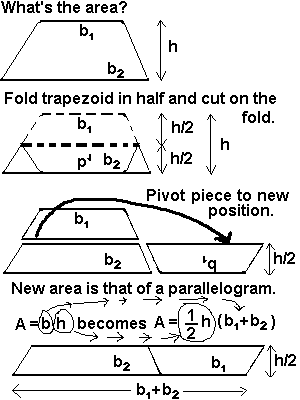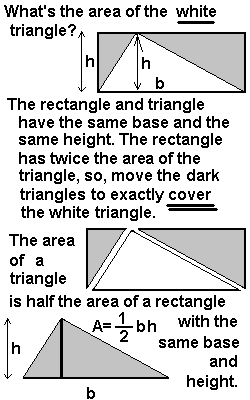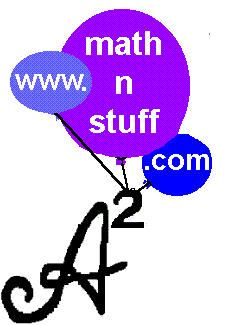Objective
- To prove each of the area formulas by paper folding and/or cutting.
|
Materials
- a pair of scissors,
- a ruler,
- a pencil,
- a sheet of rectangular paper for each of the following
formulas: parallelogram, trapezoid, triangle,
- a waste paper bag or basket,
- a set of circluar papers for
instructor use
|
|
Stuff To Review Before This Activities
Point out that opposite sides of a rectangle are parallel.
Review at least as much about area as is discussed in
rectangle, below. |
Procedure
- Review area, area of a rectangle, properties of a rectangle such as parallel
opposite sides and right angles.
-
- These proofs need not be done at the same time. Each time one is done however,
it is important to review the definition of area as the number of square units and to remind students that the
reason "length times width" or "base times height" yields area is because it supplies the number of squares covered.
-
- The rectangle must be discussed before the parallelogram.
-
- The rectangle must be discussed before the triangle.
-
- The rectangle and the parallelogram must be done before the trapezoid.
-
|
Rectangle
- Understanding why the area of a rectangle is base time height is the key to
understanding each of these paper-folding proofs of area.

- Area means number of square units.
-
- To compute the area, one must find the number of squares.
-
- The base is the number of squares across the "bottom".
-
- The height is the number of squares "high."
-
- The base times the height is the number of squares, the area.
-
|
Parallelogram
- Make the Parallelogram

- Make a parallelogram from a rectangular sheet of paper in the following way:
-
- 1st: On one edge, mark an arbitrary point A and draw a line segment to the indicated opposite vertex.
-
- 2nd: Repeat this on the opposite edge: mark point A on the edge parallel to the edge with A already marked
on it so that the distance from the edges are the same. Again draw a line segment from A to the indicated opposite vertex.
-
- 3rd: Cut the paper on the line segment.
-
- 4th: Throw away the extra pieces of paper (the shaded triangles of the picture above).
-
- Demonstrate A = bh

|
Trapezoid
- Make the Trapezoid

- Make a trapezoid from a rectangular sheet of paper in the following way:
-
- 1st: On one edge, mark an arbitrary points A and B and draw line segments to indicated opposite vertices.
-
- 2nd: Cut the paper on the line segment.
-
- 3rd: Throw away the extra pieces of paper (the shaded triangles of the picture above).
-
- Demonstrate A = (½)h(b1 + b2)

|
Triangle

DON'T THROW ANYTHING AWAY!
-
- Your goal is to create one "center triangle" (shown in white) and two other
triangular pieces (shown in gray). You need each of these triangular pieces to prove the area of a (white) triangle is
half the area of a (original piece of paper) rectangle with the same base and height.
-
- 1st: On one edge, mark an arbitrary point A and draw a line segments to each of the opposite vertices.
-
- 2nd: Cut the paper on the line segments. SAVE EACH OF THE THREE TRIANGULAR PIECES.
-
-
- Demonstrate A = (½)bh

|
This page is brought to you by MATHEMATICAL CONCEPTS, inc., publishers of
MATH SPOKEN HERE!, ISBN: 0-9623593-5-1.
You are hereby granted permission to make ONE printed copy of this page
and its picture(s) for your PERSONAL and not-for-profit use. YOU MAY NOT MAKE
ANY ADDITIONAL COPIES OF THIS PAGE, ITS PICTURE(S), ITS SOUND CLIP(S), OR ITS ANIMATED
GIFS WITHOUT PERMISSION FROM: sb@mathnstuff.com or by mail to MATHEMATICAL
CONCEPTS, inc., 85 First Street, Keyport, NJ 07735.






